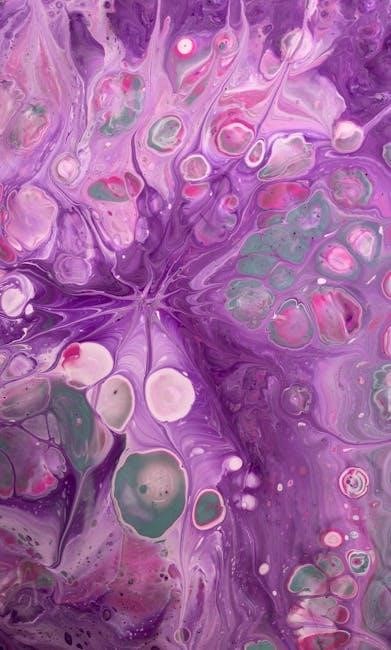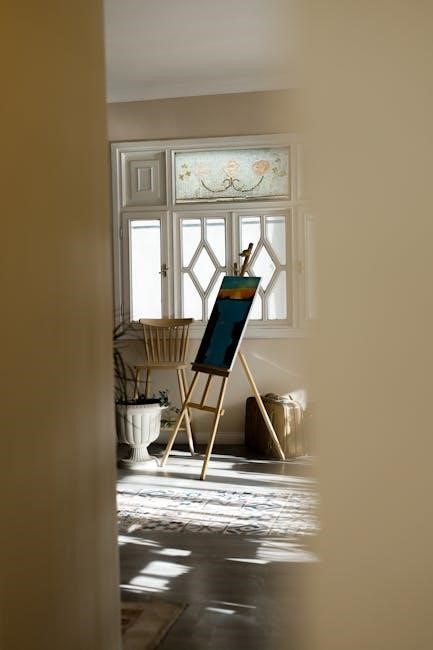Canvas sizing is crucial for ensuring your artwork or prints fit perfectly in any space, balancing aesthetics and functionality. This guide helps you make informed decisions.
1.1 Importance of Choosing the Right Canvas Size
Choosing the right canvas size is essential for creating a balanced and visually appealing display. A canvas that is too small may get lost in the space, while one that is too large can overwhelm the room. Proper sizing ensures harmony with wall dimensions, personal style, and the artwork’s purpose. It enhances the overall aesthetic, making the piece more impactful and enjoyable to view. Selecting the ideal size is critical for achieving the desired visual effect in any setting.
1.2 Brief Overview of Canvas Sizing Guide
This guide provides a comprehensive overview of canvas sizing, covering standard and custom dimensions, factors influencing size selection, and practical tips for various uses. It includes measuring wall space, understanding resolution, and framing considerations to ensure your canvas fits perfectly. Whether for photography, painting, or DIY projects, this guide offers insights to help you choose the ideal size, ensuring your artwork achieves a professional and polished look in any setting.

Standard Canvas Sizes
Standard canvas sizes offer versatile options, ensuring a perfect fit for various spaces and artistic needs, while providing consistency and ease of use for creators and decorators.
2.1 Common Canvas Dimensions
Common canvas dimensions include popular sizes like 12×12 inches, 16×16 inches, 16×20 inches, 24×36 inches, and 36×24 inches, catering to various artistic and decorative needs. These standard sizes are widely used for photography, painting, and wall decor, offering versatility and ease of framing. They are also ideal for creating balanced compositions, whether for personal projects or professional displays. Choosing the right dimension ensures your artwork fits seamlessly into any space, enhancing both functionality and aesthetics.

2.2 Purpose of Each Standard Size
Standard canvas sizes serve specific purposes, from showcasing photography to enhancing wall decor. Smaller sizes like 12×12 inches are ideal for intimate spaces or detailed artwork, while larger formats such as 24×36 inches create striking focal points. Medium sizes like 16×20 inches offer versatility for general use. Each dimension is designed to balance composition and space, ensuring the artwork complements its environment. Understanding the purpose of each size helps artists and decorators achieve the desired visual impact and functionality in their projects.
2.3 Where to Use Standard Canvas Sizes
Standard canvas sizes are versatile and can be used in various settings. Smaller sizes, like 12×12 inches, are perfect for shelves or small rooms, while larger formats such as 24×36 inches are ideal for statement pieces in living rooms or hallways. Medium sizes, like 16×20 inches, work well in bedrooms or offices. Each size can be tailored to fit the space, ensuring the artwork enhances the room’s ambiance. Proper placement maximizes visual impact and creates a harmonious interior design.
Custom Canvas Sizes
Custom canvas sizes offer flexibility for unique spaces or artistic needs, allowing you to tailor dimensions to fit specific decor or creative projects perfectly.
3.1 Benefits of Custom Canvas Sizes
Custom canvas sizes provide unmatched flexibility, allowing you to tailor your artwork or prints to unique spaces or creative visions. This ensures a perfect fit and enhances visual appeal. Whether it’s a non-standard wall dimension or a specific artistic requirement, custom sizing offers solutions. It also lets you emphasize particular design elements, making your work stand out. This personalized approach ensures your canvas seamlessly integrates with its surroundings, delivering a professional and polished look.
3.2 How to Choose Custom Dimensions
To choose custom canvas dimensions, start by measuring your wall space accurately. Consider the room’s proportions and your artwork’s aspect ratio. Use a tape measure or digital tools for precision. Refer to a canvas size chart to visualize proportions; Think about the frame’s width, as it adds to the overall size. Test mockups or use online visualizers to ensure the canvas complements the space. Finally, balance functionality with aesthetics to achieve the perfect fit for your unique needs.
3.3 Factors Influencing Custom Size Selection
When selecting custom canvas dimensions, consider wall space, room proportions, and personal style. Ensure the size aligns with the artwork’s subject and purpose. Framing and mounting options also impact the final choice. Measure accurately and use visual tools to preview the fit. Balance functionality with aesthetics for a tailored solution that enhances your space and artwork effectively.

Factors Influencing Canvas Size Choice
Wall space, room proportions, personal style, and artwork subject matter are key factors. Proper sizing ensures the canvas complements the environment without overwhelming it.
4.1 Wall Space and Room Dimensions
Measuring your wall space accurately is essential for selecting the right canvas size. A general rule is for the canvas to cover 60-75% of the wall area. Consider the room’s proportions and furniture placement, such as the size of a couch or bed, to ensure the canvas complements the space. Using a tape measure or a template can help visualize the fit; Proper sizing ensures the artwork balances the room without overwhelming it, creating a harmonious visual impact.
4.2 Personal Style and Aesthetic Preferences
Your personal style and aesthetic preferences play a significant role in choosing the right canvas size. For minimalist spaces, smaller canvases are ideal, while larger, bold pieces suit modern or eclectic styles. Consider whether you prefer portrait or landscape orientations, as this impacts the visual flow. Additionally, think about how the canvas will complement your existing decor, such as furniture and color schemes. Balancing your style with practical considerations ensures a cohesive and visually appealing result that reflects your unique taste.
4.3 Subject Matter and Artwork Type
The subject matter and type of artwork significantly influence canvas size. Detailed or complex compositions often require larger canvases to maintain clarity, while minimalist designs may thrive in smaller formats. Photography, for instance, benefits from sizes that emphasize focal points, such as 16×20 inches for portraits or 24×36 inches for landscapes. Paintings, on the other hand, may vary based on style, with abstract pieces often favoring larger, immersive dimensions. Matching the canvas size to the artwork’s purpose ensures optimal visual impact and storytelling.
Measuring Your Wall Space
Accurately measure your wall’s width and height using a tape measure. Consider orientation and leave space around the canvas for a balanced, visually appealing fit.
5.1 Steps to Measure Your Wall
Start by measuring the wall’s width and height using a tape measure. Note the dimensions and check for any obstructions like outlets or molding. Determine the orientation (portrait or landscape) for the canvas. Measure the space where the canvas will hang, ensuring it fits comfortably. Consider the 60-75% rule: the canvas should occupy this proportion of the wall. Account for furniture placement and other decor. Record the measurements accurately to guide your canvas size selection for a perfect fit.
5.2 Tools Needed for Accurate Measurement
To measure your wall accurately, use a sturdy tape measure or a laser measure for precise dimensions. A level ensures straight alignment, while a pencil marks the wall without damaging it. Graph paper helps sketch the space and visualize canvas placement. A calculator is essential for converting measurements or scaling designs. These tools collectively ensure accurate wall measurements, aiding in selecting the perfect canvas size for a seamless fit in your desired space.

Understanding Resolution and Pixel Requirements
Resolution and pixel dimensions are critical for print quality. Standard settings like 300 PPI ensure sharp images. Proper pixel count ensures your canvas looks its best at any size.
6.1 Importance of Resolution for Print Quality
Resolution, measured in pixels per inch (PPI), directly impacts the clarity and sharpness of your canvas print. A higher PPI ensures finer details and vibrant colors, while lower PPI may result in blurry images. For high-quality prints, a minimum of 300 PPI is recommended. Proper pixel dimensions are essential to maintain visual fidelity, especially for larger canvases. Ensuring the right resolution prevents pixelation and guarantees professional-looking results, making it a critical factor in achieving stunning canvas prints.
6.2 Recommended Pixel Dimensions for Different Sizes
For optimal print quality, recommended pixel dimensions vary by canvas size. A 12×8-inch canvas typically requires 1500×1000 pixels, while a 16×20-inch canvas needs 4000×2500 pixels. Larger canvases, such as 24×36 inches, should be around 6000×3000 pixels. These guidelines ensure sharp, detailed prints when maintaining a 300 PPI resolution. Proper pixel dimensions prevent pixelation and guarantee vibrant, professional-looking results, making your artwork stand out with clarity and precision.
Framing Considerations
Framing significantly impacts the perception of canvas size and overall aesthetic. The frame’s size and style can enhance or alter the artwork’s proportions and spatial balance.
7.1 How Framing Affects Canvas Size Perception
Framing can significantly alter the perceived size of a canvas, as the frame’s width and style add to the overall dimensions. A wide frame can make the artwork appear larger, while a slim frame creates a more subtle look. The frame’s color and material also influence how the canvas is viewed, drawing attention or blending seamlessly into the surroundings. Proper framing enhances the artwork’s presence, ensuring it complements the space without overwhelming it.
7.2 Choosing the Right Frame for Your Canvas
Selecting the right frame involves balancing style, material, and color to complement the artwork and room decor. Modern frames suit contemporary spaces, while classic designs enhance traditional settings. Materials like wood or metal offer durability and aesthetic appeal. The frame’s color should harmonize with the artwork and wall, ensuring a cohesive look. Additionally, frame width can add or subtract from the canvas’s visual impact, making it essential to choose one that enhances the piece without overpowering it.

Tips for Different Uses
Canvas sizing varies by use: photography requires high-resolution prints, painting needs appropriate texture, and DIY projects demand space-friendly dimensions. Choose sizes that enhance your creative vision.
8.1 Canvas for Photography
When using canvas for photography, prioritize high-resolution images to ensure clarity. Standard sizes like 12×8 inches or 16×20 inches are ideal for capturing details. For larger spaces, consider 24×36 inches to make a statement. Ensure your printer uses high DPI settings, typically 300 PPI, for crisp results. Measure your wall to select a size that complements the room without overwhelming it. This balance ensures your photos look professional and visually appealing in any setting.
8.2 Canvas for Painting
For painting, choose canvas sizes that align with your artistic goals and space. Standard sizes like 16×20 inches or 24×36 inches are popular for detail work, while larger canvases (e.g., 40×60 inches) suit bold, expressive pieces. Custom sizes allow you to tailor the canvas to your project’s needs. Consider your brushstroke style and the wall space where the artwork will hang. Proper sizing ensures your painting makes the intended visual impact, whether it’s a focal point or a subtle addition to the room.
8.3 Canvas for DIY Projects

Canvas size is essential for DIY projects, ensuring your creativity fits the intended display space. Choose smaller sizes like 12×12 inches for crafts or coasters, while larger canvases (e.g., 24×36 inches) work well for wall hangings. Consider the project’s purpose, such as custom signs or decorative panels. Select frames that complement the design, and measure the wall or surface where the piece will be displayed to ensure a perfect fit. Proper sizing enhances both functionality and visual appeal in DIY creations.
Canvas Size Chart

A quick reference guide listing standard canvas dimensions in inches and centimeters, helping users choose the perfect size for their space and artistic style.
9.1 Quick Reference Guide
This section provides a concise table of standard canvas sizes, including dimensions in inches and centimeters. It helps users quickly identify the ideal canvas size for various spaces and purposes, ensuring a seamless selection process. The guide includes small, medium, and large options, making it easy to match your artwork or prints to the available wall space effectively.
Selecting the right canvas size is vital for achieving the desired visual impact. By considering wall space, personal style, and artwork type, you can make informed decisions. Measuring accurately and understanding resolution requirements ensures high-quality prints. Whether for photography, painting, or DIY projects, the right canvas size enhances your creative vision. Use this guide to find the perfect fit, transforming your space with stunning, professionally displayed artwork that reflects your unique style and complements your environment beautifully.
